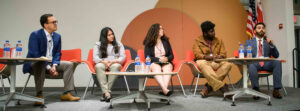This op-ed was originally published by The National Council of Teachers of Mathematics.
The question of how teachers of mathematics should structure opportunities to learn (OTL) is sometimes a difficult one to answer. In my own work, I often use OTL as a framework to explore the relationship between classroom experiences and student learning. I strongly believe that students’ learning is a result of the kinds of experiences they have in mathematics classrooms. There has been significant focus on achievement outcomes with little understanding of what happens in mathematics classrooms.
The Opportunity Myth: What Students Can Show Us About How School Is Letting Them Down—and How to Fix It, a report from TNTP, The Mathematics of Opportunity: Rethinking the Role of Math in Educational Equity, a report from the Opportunity Institute, and Checking In: Are Math Assignments Measuring Up?, a report from the Education Trust, are three recent reports that have caused me to reflect on OTL as a way of understanding students’ experiences in mathematics. I have organized my reflections around three constructs in teaching mathematics: time, tasks, and talk (Walkowiak, Pinter, and Berry 2017). I find these three constructs worthy of reflection because mathematics educators can use them as ideas to examine their own contexts as they explore the relationship between mathematical experiences and students’ opportunities to learn mathematics.
Time
In many classrooms, time is a fixed construct; that is, many teachers know how much time is allotted for mathematics instruction. Given that time is fixed, it is imperative that time be used to give students optimal opportunities to learn and engage in meaningful mathematics. Maximizing time within a lesson depends on a clearly articulated and coherent mathematical learning goal (or goals) (NCTM 2014), instructional practices focused on mathematical ideas central to those learning goals, and routines that promote productive engagement for all students in mathematical reasoning and sense making.
The Opportunity Myth and The Mathematics of Opportunity both reported that differences in exposure to mathematics content and high-quality mathematics teaching lead to differentials in mathematics experiences. Both reports highlight that students who are marginalized (students of color, those from low-income families, English language learners, and students with disabilities) are less likely to spend an optimal amount of time engaged in mathematical reasoning and sense making. We must maximize opportunities for students to engage with mathematics in meaningful ways by providing time for students to grapple with mathematics. When examining your own context using the construct of time, consider the following questions:
- How well are all lesson components connected to the mathematical goal(s)?
- How does the sequence of the lesson segments lead toward understanding the mathematical goal(s)?
- Do transitions and routines maximize or minimize instructional time?
- How is the allotted time used to support students’ opportunities for conceptual understanding or to build procedural fluency from conceptual understanding?
Task
The tasks that are planned and implemented in a mathematics lesson impact the sort of learning to which students are given access. Engagement in higher-level tasks during a mathematics lesson increases students’ engagement with mathematical ideas (Boaler and Staples 2008). The Checking In report found that roughly three-fourths of mathematics assignments given to middle school students have low cognitive demand, overemphasize procedural skills and fluency without understanding, and provide little opportunity for students to communicate their mathematical thinking. This tendency was worse in schools with higher poverty. We must do more to provide students with mathematics tasks that promote cognitive challenge, provide opportunities for reasoning and sensemaking, and deepen mathematical understanding by asking students to translate among multiple representations. When examining your own context using the construct of task, consider the following questions:
- Is the task(s) grade appropriate?
- How does the task(s) elicit higher-level thinking and engagement with mathematical ideas?
- How does the implementation of task(s) support students in making sense of mathematics?
- Does the task(s) involve the use of and translation among two or more representations to deepen mathematical understanding?
Talk
The presence of student talk in classroom lessons is necessary but not sufficient to promote deeper learning. Talking and listening are key first steps toward fostering mathematical discourse, where the teacher must pose purposeful questions, elicit student thinking, and facilitate meaningful discourse (NCTM 2014). Teachers must find the balance between allowing students to express thinking freely while keeping the focus on the mathematical learning goal(s). Mathematical discourse is a multidimensional practice where students and the teacher share ideas, questions, and other mathematical wonderings to build mathematical understanding. The Mathematics of Opportunity acknowledges mathematical discourse as an equitable instructional practice. Those who talk and are heard in mathematical discourse are positioned as mathematically competent. As such, it is imperative that we provide opportunities for each and every student to talk and to have their ideas heard during mathematics lessons. When examining your own context using the construct of talk, consider the following questions:
- Who has opportunities to talk about their mathematical ideas and thinking, and to reason mathematically?
- Who is heard and not heard during mathematical discourse? Whose ideas are taken up and valued as contributing to the collective learning?
- How is the mathematical discourse supportive of mathematical goal(s)?
- In what ways does mathematical discourse deepen students’ ideas about mathematics?
I encourage you to read The Opportunity Myth, The Mathematics of Opportunity, and Checking In to further your reflections on students’ opportunities to learn mathematics. Please share your reflections on MyNCTM.org.
References
Boaler, Jo, and Megan Staples. “Creating Mathematical Futures through an Equitable Teaching Approach: The Case of Railside School.” Teachers College Record 110, no. 3 (2008): 608–45.
National Council of Teachers of Mathematics (NCTM). Principles to Actions: Ensuring Mathematical Success for All. Reston, Va.: NCTM, 2014.
Walkowiak, Temple A., Holly H. Pinter, and Robert Q. Berry III. “A Reconceptualized Framework for ‘Opportunity to Learn’ in School Mathematics.” Journal of Mathematics Education at Teachers College 8, no. 1 (2017).





